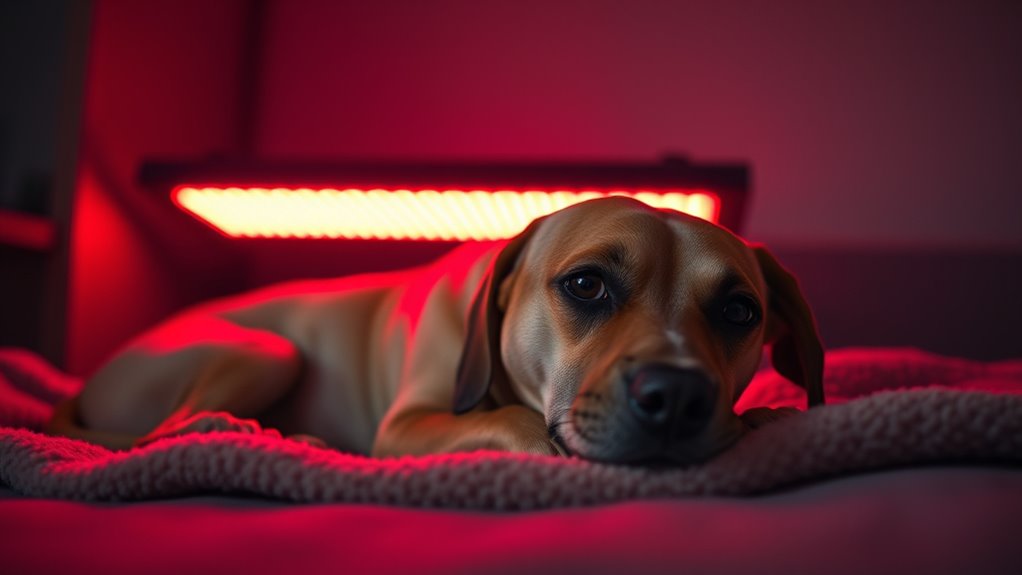Red-light therapy for pets is an emerging treatment that offers numerous benefits, including pain relief, reduced inflammation, and faster healing of skin issues like wounds and dermatitis. It’s non-invasive, easy to use, and can be administered at home or during vet visits, making it a safe option for sensitive or anxious animals. As research progresses, you’ll discover more about how this innovative approach can improve your pet’s quality of life.
Key Takeaways
- Red-light therapy alleviates pain from arthritis, injuries, and chronic conditions in pets with minimal side effects.
- It promotes skin healing, reduces inflammation, and improves coat health for various dermatological issues.
- The therapy is safe, non-invasive, and easy to administer at home or veterinary clinics with proper guidance.
- Emerging applications include treating wounds, hot spots, and enhancing overall tissue regeneration in pets.
- Ongoing research and new pet-specific devices continue to expand the benefits and protocols of red-light therapy.

Have you ever wondered how red-light therapy can benefit your pets? This innovative treatment is gaining popularity among pet owners and veterinarians alike for its ability to address a variety of health concerns. One of the primary reasons people turn to red-light therapy is for pain management. If your furry friend suffers from arthritis, injuries, or chronic discomfort, red light can help reduce inflammation and alleviate pain. The therapy works by penetrating deep into tissues, encouraging cellular repair and boosting circulation. As a result, your pet may experience less soreness and more mobility, often with fewer side effects compared to traditional medications. Red-light therapy is non-invasive, making it a comfortable option for pets who might be anxious or sensitive to medications or surgical procedures.
Red-light therapy eases pet pain, promotes healing, and is a safe, non-invasive treatment option.
In addition to pain management, red-light therapy offers remarkable benefits for skin rejuvenation. Pets with skin conditions like dermatitis, hot spots, or wounds can see significant improvements with regular treatments. The therapy stimulates collagen production, which helps repair damaged skin and promotes a healthier, more vibrant coat. It can also accelerate the healing process of cuts, surgical incisions, or ulcers, reducing scars and minimizing discomfort. Many pet owners notice that their animals’ skin looks healthier and their coats become shinier after a series of sessions. This makes red-light therapy not just a remedy for existing issues but a preventative measure to maintain your pet’s overall skin health.
Implementing red-light therapy is straightforward and safe when done correctly. You can find specialized devices designed for pets, which are easy to use at home or during vet visits. These devices emit specific wavelengths of red light that are absorbed by your pet’s tissues, triggering beneficial biological responses. Sessions are generally quick, often lasting around 10 to 20 minutes, and can be tailored to your pet’s needs. Consistency is key, so regular treatments can enhance long-term outcomes. Many pet owners report noticeable improvements within a few sessions, especially when combined with a holistic approach to pet care.
While red-light therapy is generally safe, it’s essential to consult your veterinarian before starting treatment, especially if your pet has underlying health conditions. Proper guidance ensures that your pet receives the right dosage and duration for ideal results. As red-light therapy continues to evolve, more pet-specific products and protocols are becoming available, making it easier for you to provide your furry friend with a safe, effective, and non-invasive way to improve their quality of life.
Frequently Asked Questions
Are Red-Light Therapy Devices Safe for All Pet Breeds?
Red-light therapy devices are generally safe for most pet breeds, but you should consider breed-specific safety. Some breeds may have sensitive skin or unique health issues that require extra caution. Always consult your veterinarian before starting treatment to ensure device efficacy and safety tailored to your pet’s breed. Proper use and monitoring help prevent adverse effects, making red-light therapy a beneficial option for many pets.
How Long Does a Typical Red-Light Therapy Session Last for Pets?
Think of a red-light therapy session as a gentle sunrise for your pet’s health—lasting about 15 to 20 minutes. You typically do this once or twice a day, depending on your veterinarian’s advice. The session duration is designed to optimize benefits without overstimulation. Consistent therapy frequency helps improve conditions like arthritis or skin issues, making each session a meaningful step toward your pet’s well-being.
Can Red-Light Therapy Replace Traditional Veterinary Treatments?
Red-light therapy can’t replace traditional veterinary treatments, but it can complement them as part of holistic healing. You should see it as an alternative medicine option that supports your pet’s recovery and overall well-being. Always consult your vet before integrating red-light therapy into your pet’s care plan. It’s an effective adjunct that may enhance healing, reduce inflammation, and improve comfort, but it shouldn’t be relied on solely for serious health issues.
Are There Any Side Effects or Risks Associated With Pet Red-Light Therapy?
You might think red-light therapy is completely risk-free, but potential allergic reactions can happen, and eye safety precautions are essential. While side effects are rare, some pets may experience skin irritation or sensitivity. Always monitor your pet closely and follow your veterinarian’s guidance to minimize risks. Proper use and precautions help make sure your pet benefits safely from this emerging treatment without unintended side effects.
How Often Should Pets Undergo Red-Light Therapy for Optimal Results?
You should follow the frequency guidelines provided by your veterinarian or pet therapy specialist. Typically, treatment scheduling involves 2-3 sessions per week initially, then gradually reducing as your pet improves. It’s important to monitor your pet’s response and adjust accordingly. Regular sessions help maximize benefits like pain relief and inflammation reduction. Always consult your vet to personalize the treatment plan, ensuring safety and ideal results for your pet.
Conclusion
Imagine your pet basking in a gentle, healing glow like dawn breaking after a long night. Red-light therapy is emerging as a promising tool to ease their pain and boost recovery. Just as sunlight renews the earth, this treatment can revitalize your furry friend’s health. Many pet owners are already witnessing their pets leap back to life, proof that this innovative therapy is lighting the way toward happier, healthier lives for our beloved companions.








